|
||||||||||||||||||||||
![Home - Air Power Australia Website [Click for more ...]](APA/APA-Title-Main.png) |
||||||||||||||||||||||
![Sukhoi PAK-FA and Flanker Index Page [Click for more ...]](APA/flanker.png) |
![F-35 Joint Strike Fighter Index Page [Click for more ...]](APA/jsf.png) |
![Weapons Technology Index Page [Click for more ...]](APA/weps.png) |
![News and Media Related Material Index Page [Click for more ...]](APA/media.png) |
|||||||||||||||||||
![Surface to Air Missile Systems / Integrated Air Defence Systems Index Page [Click for more ...]](APA/sams-iads.png) |
![Ballistic Missiles and Missile Defence Page [Click for more ...]](APA/msls-bmd.png) |
![Air Power and National Military Strategy Index Page [Click for more ...]](APA/strategy.png) |
![Military Aviation Historical Topics Index Page [Click for more ...]](APA/history.png)
|
![Intelligence, Surveillance and Reconnaissance and Network Centric Warfare Index Page [Click for more ...]](APA/isr-ncw.png) |
![Information Warfare / Operations and Electronic Warfare Index Page [Click for more ...]](APA/iw.png) |
![Systems and Basic Technology Index Page [Click for more ...]](APA/technology.png) |
![Related Links Index Page [Click for more ...]](APA/links.png) |
|||||||||||||||
![Homepage of Australia's First Online Journal Covering Air Power Issues (ISSN 1832-2433) [Click for more ...]](APA/apa-analyses.png) |
||||||||||||||||||||||
| Last Updated: Mon Jan 27 11:18:09 UTC 2014 | ||||||||||||||||||||||
|
||||||||||||||||||||||
|
||||||||||||||||||||||
![Home - Air Power Australia Website [Click for more ...]](APA/APA-Title-Main.png) |
||||||||||||||||||||||
![Sukhoi PAK-FA and Flanker Index Page [Click for more ...]](APA/flanker.png) |
![F-35 Joint Strike Fighter Index Page [Click for more ...]](APA/jsf.png) |
![Weapons Technology Index Page [Click for more ...]](APA/weps.png) |
![News and Media Related Material Index Page [Click for more ...]](APA/media.png) |
|||||||||||||||||||
![Surface to Air Missile Systems / Integrated Air Defence Systems Index Page [Click for more ...]](APA/sams-iads.png) |
![Ballistic Missiles and Missile Defence Page [Click for more ...]](APA/msls-bmd.png) |
![Air Power and National Military Strategy Index Page [Click for more ...]](APA/strategy.png) |
![Military Aviation Historical Topics Index Page [Click for more ...]](APA/history.png)
|
![Intelligence, Surveillance and Reconnaissance and Network Centric Warfare Index Page [Click for more ...]](APA/isr-ncw.png) |
![Information Warfare / Operations and Electronic Warfare Index Page [Click for more ...]](APA/iw.png) |
![Systems and Basic Technology Index Page [Click for more ...]](APA/technology.png) |
![Related Links Index Page [Click for more ...]](APA/links.png) |
|||||||||||||||
![Homepage of Australia's First Online Journal Covering Air Power Issues (ISSN 1832-2433) [Click for more ...]](APA/apa-analyses.png) |
||||||||||||||||||||||
| Last Updated: Mon Jan 27 11:18:09 UTC 2014 | ||||||||||||||||||||||
|
||||||||||||||||||||||
| Fourth
Generation
AAMs - The Rafael Python 4 |
|||
|
|||
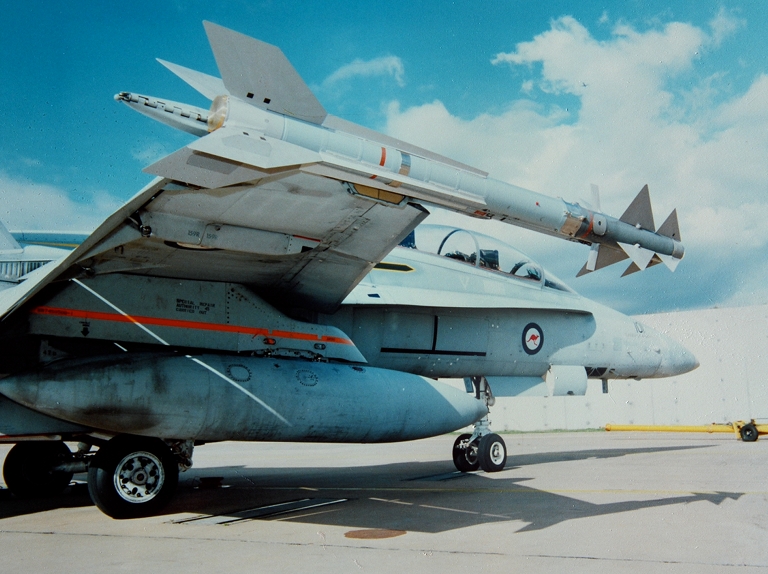 Python
4 fit
check on F/A-18B in 1997 (Rafael image).
Air superiority is the primary mission of any modern air force. For this reason, Air-Air Missile (AAM) technology is a critical driving factor which in many instances can determine the outcome of an air battle. The nineties are seeing yet another paradigm in AAMs, with the operational deployment of what are termed agile or fourth generation Within Visual Range (WVR) or dogfight AAMs. These missiles will, much like previous generational steps in AAM design, force another rewrite of tactical air superiority doctrine and fighter weapon system design. The driving impetus for this new generation of AAMs came from the former USSR, indeed when it was still the USSR. Faced with overwhelming Western technical superiority in fighter and AAM design, the Soviets deployed the impressive Su-27SK Flanker B during the last years of the Cold War. As well, they also deployed the revolutionary Vympel R-73 / AA-11 Archer AAM. The AA-11 was different from the preceding generation of AAMs in two important areas. It was aerodynamically "agile", using a two stage nose canard design and thrust vectored exhaust to achieve turn rate performance well beyond established missiles such as the AIM-9L/M. It also employed an "agile" gimballed seeker, believed to use a multiple detector cross array, capable of tracking targets at very large off boresight angles reported to be significantly greater than 45 degrees, at high angular tracking rates. What this means is that the Archer can be locked on to targets in an engagement geometry where an older missile cannot see the opponent, it also means that once the missile is fired, it can maintain its seeker locked on to its target despite violent manoeuvring which would force the target out of the seeker's field of view (FOV) with any older missile. The Archer therefore had the turn rate performance to allow its user to exploit engagement geometries which were unavailable to earlier third generation missiles such as the AIM-9L/M, as well its seeker allowed its user to fire the missile in geometries which were unusable by earlier missiles. Because the missile had such high aerodynamic and seeker agility, the opponent would have little chance of defeating the missile through aggressive manoeuvre. Both the Su-27 and the MiG-29 were equipped with Helmet Mounted Sights (HMS) which allowed the pilot to lock the missile on to a target well before the fighter's nose was "swung" to a position where the Air Intercept (AI) radar could lock up the target. A third generation missile such as the AIM-9L/M has an all-aspect seeker which is slaved to the fighter's radar, and therefore can only be locked on to what the radar can geometrically "see". The Su-27 and MiG-29 would therefore get many and earlier firing opportunities if well flown. This however was only one side of the equation, as the Russians also evolved the Su-27 to achieve what is termed today "super-manoeuvrability", which is the ability to maintain controlled flight at extreme angles of attack. This gave the late model Flanker a better ability to survive an attack from an established third generation AAM, by aggressively manoeuvring the aircraft to force the inbound AAM's seeker to break lock. The thrust vectoring Su-30MKI, 40 of which were recently purchased by India (see AA 1/97), further extends the superlative agility of the basic aircraft. To clarify this evolutionary path it is useful to take a brief look at the evolutionary steps we have seen in AAM design over the last four decades. First generation AAMs such as the AIM-9B and the AA-2 Atoll had short wavelength (usually Zinc Sulfide or Germanium) tail aspect seekers with a narrow field of view and limited field of view and tracking rates. A successful engagement required that you position your fighter into a narrow 30 degree cone behind the target, and hope the victim would not jink or turn as this would most often cause your missile to break lock (see AA 7/87). The following second generation AAMs, typified by the AIM-9D/G and H (see AA 4/94) or Israeli Shafrir 2, only slightly improved this situation, by providing a wider 45 degree aspect angle, and slightly larger seeker field of view and tracking rates. Again a successful engagement required that you assume a tailchase geometry, shot your missile and hope that the bad guy doesn't initiate a hard turn. An interesting statistic is that typical dogfights using first and second generation AAMs required up to 5 to 7 minutes of aggressive manoeuvre until one or the other party acquired enough positional advantage to get a shot. Needless to say if you are preoccupied with outmanoeuvring your opponent, you are vulnerable to a third player getting up your six and doing it to you first. The teen series fighters were designed for energy manoeuvrability and sustained turn rate performance primarily to provide earlier firing opportunities with such missiles, and a better ability to dodge such missiles. While the first of these fighters were entering service, the third generation of dogfight AAMs emerged. These are typified by the use of a 4 micron band (Indium Antimonide) seeker, capable of locking on to a target from any aspect, and are thus termed "all-aspect" AAMs. Two Sidewinder derivatives were developed during this period, the AIM-9L and German BGT ALASCA, both of which involved fitting a new 4 micron band optical system to the established AIM-9H airframe and controls. The "Lima" was a star performer in the Falklands air battles. The ALASCA died a quiet political death, with BGT licencing the "Lima". The third generation AAM brought with it another paradigm in air combat doctrine. As the missile could be locked from any target aspect, and allowed off boresight engagements to angles between 15 and 30 degrees, the issue became one of getting the nose on to the target as quickly as possible. Instantaneous turn rate became a critical performance issue in fighters, indeed the enlarged horizontal tail of the F-16C/D and the digital flight control systems of the F-16C/D and F/A-18 had much to do with this basic requirement. The MiG-29 and Su-27, conceived in the early seventies and deployed in the early eighties, were aerodynamically optimised for this model of air combat, with instantaneous turn rates in excess of 20 degrees per second at dogfight speeds. A typical dogfight duration for such aircraft and missiles would be 3 minutes per engagement. The exploitable weakness of the third generation AAMs lay in the need to get the nose within 15-30 degrees of the target during an engagement (ie off boresight angle), and the aerodynamic and seeker tracking rate limitations which could allow a highly manoeuvrable fighter type target to force the missile to break lock. Since this generation of missiles typically used short burn high impulse motors, their manoeuvre performance declined in the "end-game" phase of the engagement as they are essentially coasting on inertia, further exacerbating these basic weaknesses. 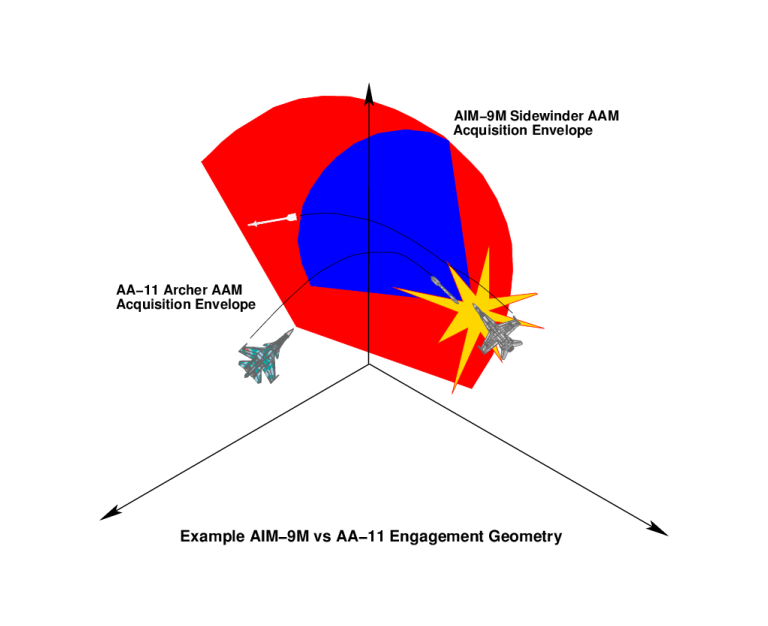 The Soviet deployment of the Archer and the Flanker/Fulcrum provided a combination of missile capability and airframe manoeuvrability which would allow a competent pilot to get earlier firing opportunities, higher missile kill rates and better survivability against a teen series fighter shooting a third generation missile. The importance of this paradigm did not become fully apparent or appreciated in the West until the Luftwaffe absorbed the defunct GDR Air Force and its Fulcrum/Archer air defence squadrons. Lengthy evaluation and air combat exercises by the highly competent Luftwaffe quickly revealed that while the Fulcrum was next to useless for the US favoured Beyond Visual Range (BVR) combat, the aircraft was a superb dogfighter and the combination of Archer and HMS provided a revolutionary capability in the close in dogfight (incidently the first operational HMS was used in the seventies and eighties by the USN on late model F-4N carrying the AIM-9H - it was phased out with the "Hotel"). The recently announced development of the evolved R-73M Archer with a 60 degree off boresight capability and range performance improvement from 16 to 22 NM underscored the growing imbalance between Western and Russian WVR missile capabilities (Vympel have also stated that a gimballed rocket exhaust nozzle is under development, to increase manoeuvre performance against the existing deflector vane based scheme used in the missile). This very recently produced a panic reaction in the US, as the Americans had invested enormous effort in to the AIM-120 AMRAAM while backing out of the previous agreement to acquire the European AIM-132 ASRAAM, currently planned for deployment next year with RAF squadrons. Indeed the US are at this time still in the throws of deciding ultimately what to do about this state of affairs. An evolved Sidewinder with a 5" motor is their currently favoured alternative, the US having rejected the UK ASRAAM. Industry sources suggest that the US decision is driven by the need to fit a maximum weapon load into the internal bays of the F-22, while the IOC for the new missile is still unclear. Closer to home, air superiority remains central to RAAF air power doctrine. The RAAF has always maintained a very high standard of operational proficiency and a technological advantage in the regional air superiority game. When the F/A-18A was acquired, regional capabilities were limited to the Flogger, Fishbed and Farmer, equipped with second generation AAMs. Such aircraft were no match for an F/A-18A shooting the AIM-9 Lima or Mike. The RAAF now faces a regional air combat environment where several players have deployed a range of Flanker variants equipped with a range of AAMs. The Flanker has twice the combat radius of the Hornet, better energy manoeuvrability, high angle of attack manoeuvrability, instantaneous turn rate, and equipped with the Archer and a HMS, a much better dogfight weapon system. Since the Flanker's NIIP N-001 AI radar outranges the Hornet's APG-65, and the 50 NM Vympel R-77 / AA-12 Adder (Amraamski) outranges the BVR AIM-7M Sparrow, the F/A-18 has been clearly outclassed both in BVR and WVR combat, and outclassed in combat radius / combat persistance by a factor of two. The Flanker is now deployed regionally by India, China and Vietnam. The PRC is currently planning the licence production of the Su-27, and possibly later Flanker variants. There are four things the RAAF can do to offset this imbalance, since the alternative of replacing the F/A-18 with the F-15 is not an option. The first is to acquire a new AAM suite for BVR and WVR combat, the second is to acquire a new AI radar, the third is to apply radar cross section reduction measures to the airframe, and the fourth is to acquire an operational AAR tanker force with the numbers to support the 81 WG TFW to twice its existing combat radius. All of these measures are now imperative if we wish to maintain the RAAF's credibility as the region's most capable air force, and thus benefit from its deterrent value. The acquisition of new AAMs is now being acted upon, with the announcement of AIR 5400 which will see the purchase of a new WVR and a new BVR missile for the Hornet. This indeed brings us to our central topic, the Israeli fourth generation AAM. The Rafael Python 4 Israel has had the unenviable experience of being surrounded by much larger neighbours most of whom, since 1948, have had an openly declared intention to destroy the Jewish state. Since 1948, the Israelis have fought a number of wars in order to initially survive, and later to secure their borders. In every single instance, air superiority proved to be the decisive factor in achieving both tactical and strategic victories on the battlefield. Current Israeli military doctrine accords the maintenance of air superiority the highest priority. One of the consequences of Israel's military experience since the sixties has been to develop a strong domestic capability to design and manufacture modern military equipment and weapons. Indeed their experience in the sixties, when France unilaterally withdrew all support for French equipment in Israeli service, and more recently US dithering over the supply of aircraft has led the Israelis to source as many "consumables" as possible from domestic manufacture. Since the WVR AAM is such a critical component of the air superiority game, the Israelis have been building their own since the early sixties. The first Israeli AAM to see production was the Rafael Shafrir (Dragonfly) I in the early sixties, a contemporary of the AIM-9B. It was followed by the improved Shafrir II, in production between 1968 and 1980 and credited with over 100 kills, mainly during the 1973 Yom Kippur war. The third generation Python 3, a contemporary of the AIM-9L/M, was introduced during the late seventies and is credited with over 35 Syrian aircraft kills during the Bekaa Valley air battle in 1982. Both the Shafrir and the Python 3 utilise a similar aerodynamic and control configuration to the AIM-9, but are unique missile designs. The fourth generation Python 4 was developed during the late eighties and early nineties, deploying on Israeli F-15 and F-16 fighters during the early nineties. The missile and its associated Elbit DASH (Display And Sight Helmet) third generation HMS were developed specifically to outperform the Soviet Archer/HMS and MiG-29, both of which deployed in the Middle East by the early nineties. The Python 4 is a true fourth generation missile, designed from the ground up for the demanding requirements of this style of air combat. It employs an all aspect gimballed seeker designed for large off boresight acquisition and tracking angles, and a high tracking rate. It also employs a new powerplant, and unique aerodynamics specifically optimised for high agility. The intent of the designers was to produce a missile which can not only be shot from a wider range of angles than earlier missiles, but which can also maintain track on a highly manoeuvrable high G target engaged during the merge or opening phase of an engagement. A passing target on a reciprocal heading can be engaged in most of the forward hemisphere, if the Python fails its first opportunity to hit, it will maintain track on the target and continue a tail chase geometry pursuit on a reciprocal heading to the launch aircraft, running down the target for a tail-aspect hit. The missile is claimed to have sufficient turning performance to defeat high G evasive manoeuvre by any existing fighter aircraft. Existing ACM experience with the missile suggests a typical engagement duration of much less than 30 seconds. This capability was achieved by carefully optimising seeker, aerodynamic and powerplant performance. The seeker was incorrectly reported by US sources to be a cooled two colour rotating reticle design, Israeli sources will only acknowledge that the missile usesa multiple detector array seeker, which has an IRCCM (ie IR ECCM) capability and the ability to reject background IR radiation. Typical two colour seekers (eg FIM-92C Stinger) use an Argon cooled InSb 4 micron IR detector and a Si or GaAs UV detector. Valid aircraft targets have a low UV signature and a high IR signature and this enables the Stinger to easily reject spurious targets such as flares. The Python 4 seeker has been credited with significantly better acquisition range than that of the AIM-9M, which is consistent with the sensitivity improvement produced by a multiple element seeker. 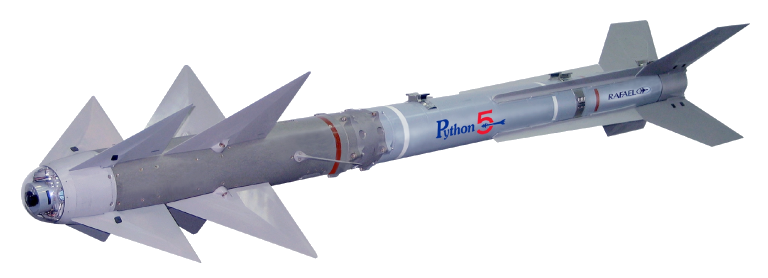 The Python 4 is known to employ digital signal processing techniques in the seeker, as well as a microprocessor based digital flight control system. The use of DSP (Digital Signal Processing) techniques will provide the seeker with better acquisition range than analogue seekers by exploiting the multiple detector elements to full advantage, as well as providing further IRCCM capability and the ability to intelligently manage fluctuating target signatures. A digital flight control system will allow the missile to optimise its flight control laws for the regime of flight, while also selectively choosing the most suitable homing algorithm parameters for the geometry of the engagement. The Python 4 missile employs a unique tailored proportional navigation homing algorithm. As a result of these design features, the Python 4 seeker is credited with the capability to engage and track targets throughout most of the forward hemisphere (the exact figure has not been disclosed, UK sources suggest in excess of 60 degrees off-boresight capability), with a high but undisclosed tracking rate. The missile employs a blast fragmentation warhead which is triggered by an active laser proximity fuse with a backup impact fuse, a design feature in common in the AIM-9, but different from the Archer which employs a radio proximity fuse. The warhead size has not been disclosed. The Python 4 employs a 6 in diameter rocket motor, a feature it shares with the Archer and the ASRAAM. The long burn motor has a tailored thrust profile to achieve optimal acceleration for close-in closing engagements and high energy for terminal phase homing or end-game engagement. Thrust vectoring is not employed, the missile instead utilises aerodynamic design to achieve a high turn rate throughout the its flight envelope. The aerodynamic design of the Python is by any standard the most complex in any existing AAM, and is evidently intended to provide the best possible lift throughout the flight profile of the weapon. A cruciform fixed canard is mounted on the nose to stabilise high angle of attack airflow over the cruciform canard control surfaces, which are used for pitch and yaw control, a technique used by a number of existing WVR AAMs. Roll control is achieved by a small pair of "paddle" vanes aft of the controls. The missile employs highly swept strakes along the fuselage which are intended to improve airflow characteristics over the tail surfaces. The swept tail surfaces are designed to swivel about the fuselage, this is designed to minimise lift induced rolling moments at high angles of attack in high G turns. The combination of a long burn motor and complex aerodynamic design will provide the Python 4 with a high sustained turn rate at all speeds, and this will in turn translate into an ability to follow a high G target throughout any manoeuvre. The missile is credited with much better range performance than the AIM-9M, and better maximum G capability than any existing AAM. The Python 4 is compatible with all standard AIM-9 capable launchers, and has been tested and cleared for use on the F-15, F-16, F/A-18 and F-5. The only integration requirement for the basic missile is the replacement of the launcher internal electronic unit with a Python capable design, which retains compatibility with the AIM-9. To fully exploit the missile's capability, a Helmet Mounted Sight is required, which will necessitate the fitting of cockpit transducers and supporting electronics. The DASH HMS supports either an analogue or digital interface. Aircraft such as the F/A-18 will also require some changes to the fire control software, to enable selection of the HMS or radar for missile boresight control. The F/A-18 could carry up to six rounds on wingtip and pylon stations. The Python 4 is currently being bid for the AIR 5400 requirement, and the RAAF have acknowledged that captive carry tests were flown by ARDU late last year. No further details have been disclosed at this time. Summary The introduction of fourth generation WVR AAMs such as the Python 4 will require a fundamental revision of many aspects of existing close-in air combat doctrine. Missiles in this class pose potential operational hazards, as a clumsy user could easily shoot down his wingman (done by an Iraqi MiG-29 pilot in early 1991). More importantly, dogfighting a competent opponent who uses such missiles imposes much pressure to get the first round off. Whoever shoots first is likely to win. This will in turn increase the need for early acquisition and identification of targets, as well a significant improvement in onboard IR countermeasures (ie jammer) capability will be required. Unless Rules of Engagement allow the shooting of BVR missiles without positive visual ID of the target, a close in visual dogfight will follow. Under these conditions, the capability of the WVR missile used and its supporting HMS weapon system could well be decisive factors in the engagement. The importance of a pilot's manoeuvring skills and aircraft manoeuvre performance is likely to decline. Until such time as the RAAF deploys a fourth generation WVR AAM, the technological edge in close in combat will not lie with the RAAF. We can hope that the missiles selected under AIR 5400 will be deployed at the earliest possible date. 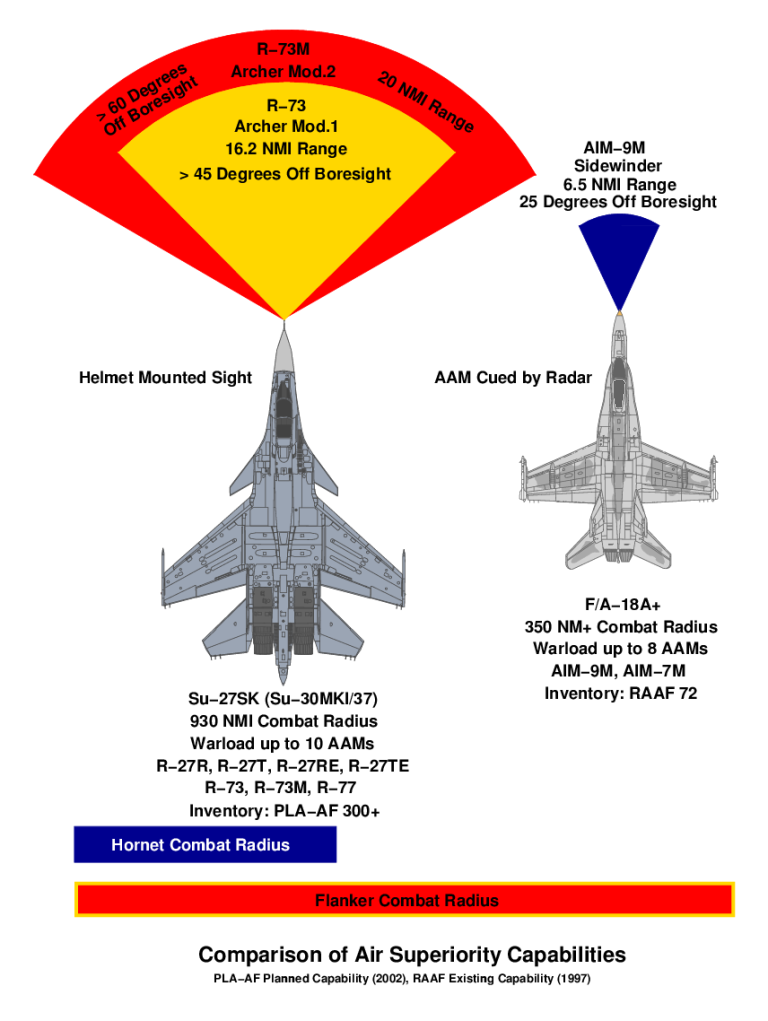 A Flanker or Fulcrum firing the AA-11 Archer and AA-12 Adder outguns the F/A-18A firing the AIM-9M and the AIM-7M by a significant margin. The Vympel R-73 Adder is a true fourth generation WVR AAM with thrust vectoring and a significant off-boresight acquisition capability using the helmet mounted sight, the follow-on R-73M will have a 20+ NM range and an even greater off-boresight capability. This 232 lb (105 kg) AAM carries a 16 lb (7.5 kg) warhead, and has a useful envelope between 300 metres and 16.2 NM (30 km). The Vympel R-77 (Amraamski) is an active radar guided BVR AAM and is designed to engage 12 G targets, using unique "grid" control surfaces to achieve additional control force at high AoA. The R-77 weighs in at 386 lb (175 kg), and has a useful range at altitude of up to 48.6 NM (90 km). This missile, like the Amraam, uses datalink midcourse guidance and active terminal homing, supports an LOBL off-the-rail active launch mode and has a home-on-jam (HOJ) capability. Carried by the Flanker and Fulcrum, the missile requires the APU-170 pylon adaptor, and a late model AI radar such as the Phazotron Zhuk (Author). 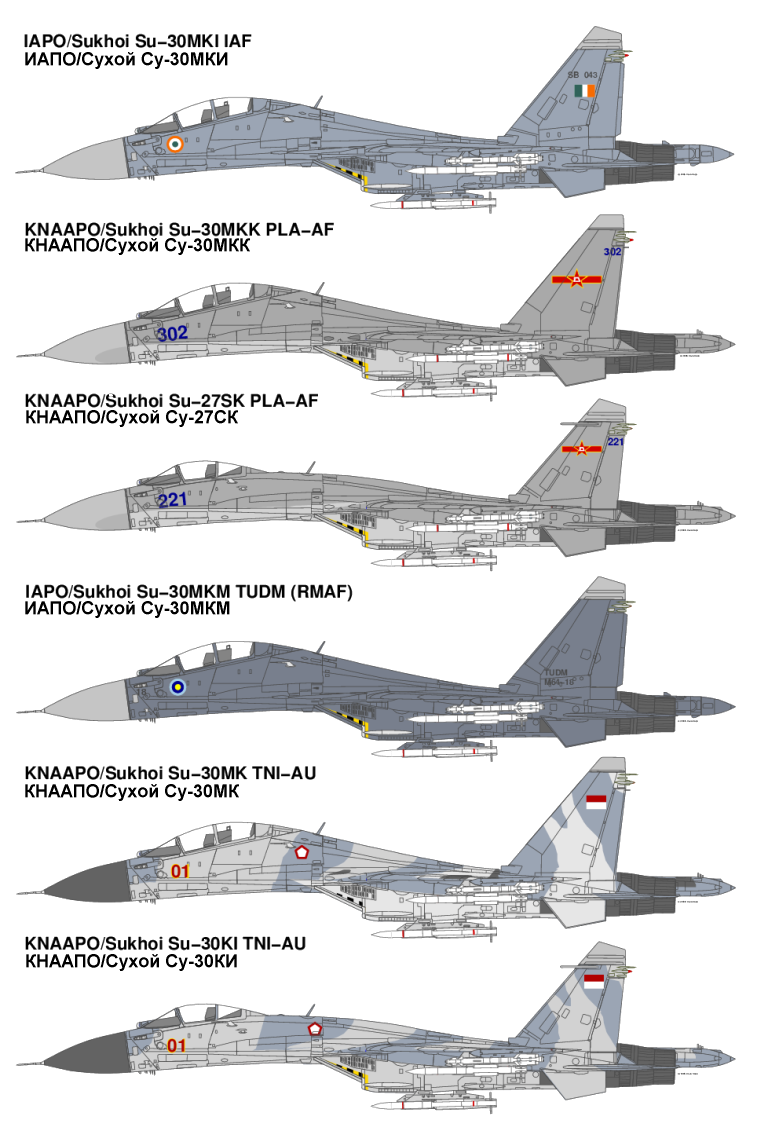 South East Asia's worst nightmare come true ? The Indian Air Force expects to deploy the potent Su-30MKI thrust vectoring canard Flanker by the year 2000, equipped with the Archer and Adder AAMs. A number of sources suggest that the PRC would like this aircraft as well, going beyond the currently purchased 103 units of the standard Su-27SK and the planned 200 unit licence build. The Flanker has twice the combat radius of the F/A-18A+, higher energy manoeuvrability, higher sustained and instantaneous turn rate, a longer ranging radar and substantially larger missile load. Advanced variants such as the Su-30MKI/Su-35/37 have unsurpassed manoeuvre performance, especially in the demanding high AoA, high G regime of flight (Author). 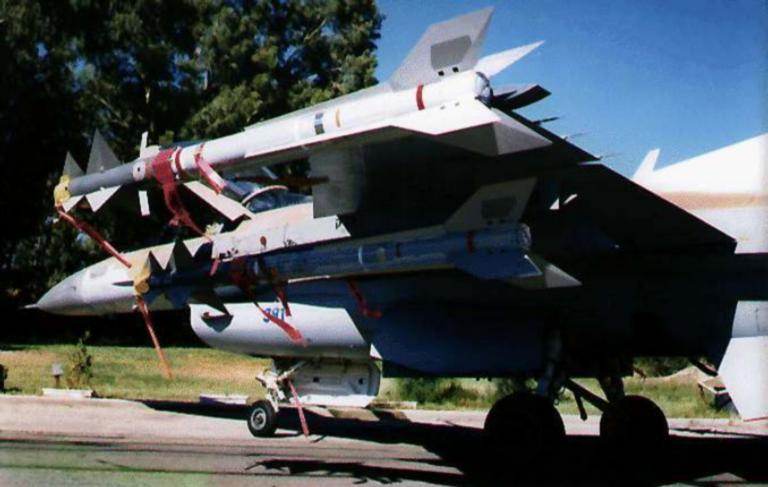 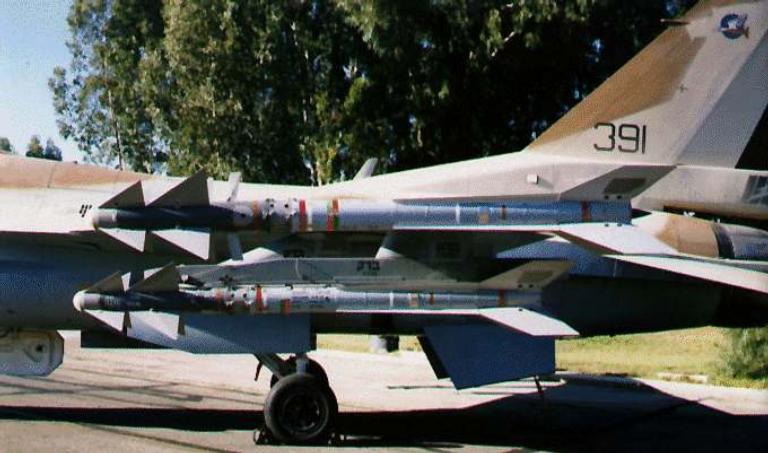 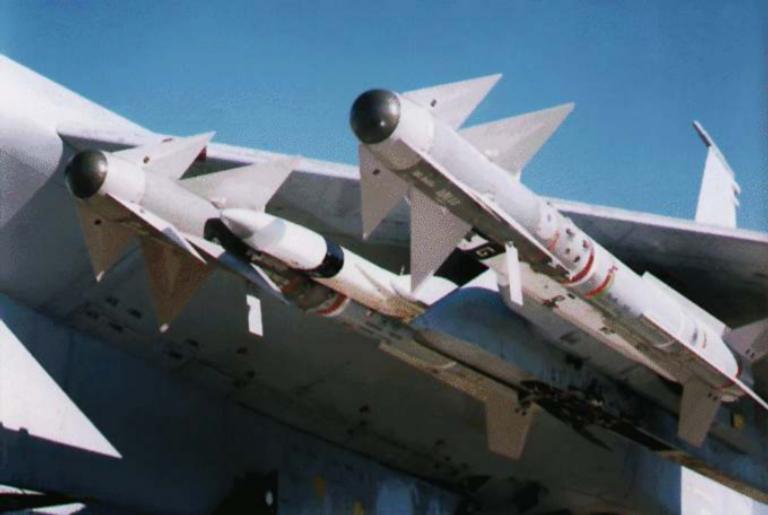 The Rafael Python 4 is the first fourth generation dogfight missile to be operationally deployed in the West, in use on the F-15C and F-16C of the Israeli Air Force. Unlike its thrust vectoring CIS counterpart, the Python relies upon clever aerodynamic design and a profiled long burn rocket motor to achieve a very wide high G performance envelope. Equipped with a gimballed all aspect seeker which has a off-boresight capability covering most of the forward hemisphere with a very high angular tracking rate, this missile is specifically designed to counter late model CIS fighters equipped with the AA-11 Archer. Note the fixed forward canards, movable control canards, roll control vanes and swivelling tail surfaces (Author). 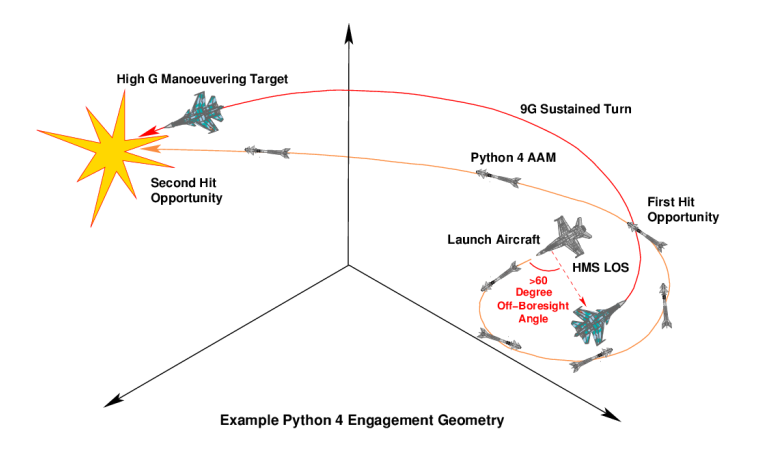 This diagram illustrates an example engagement using the Python 4, which has the capability to track a high G target and continue the engagement even should the first hit opportunity not be exploited. In this instance the target aircraft evades the missile's first pass, but is subsequently run down and destroyed. The "no escape zone" of the Python is vastly greater than that of third generation missiles, while almost any target in the forward hemisphere can be engaged using the Elbit DASH Helmet Mounted Sight (Author).  The Python 4 is being bid for the RAAF's AIR 5400 WVR AAM requirement. Last year ARDU performed captive carry tests with the missile. This missile has been tested and cleared for carriage on the F-15, F-16, F/A-18 and F-5E. It has yet to be used operationally although its predecessor, the third generation Python III, is credited with 35 kills in the 1982 Bekaa Valley air battle (Rafael). |
|||
|
|||||||||||||
![Sukhoi PAK-FA and Flanker Index Page [Click for more ...]](APA/flanker.png) |
![F-35 Joint Strike Fighter Index Page [Click for more ...]](APA/jsf.png) |
![Weapons Technology Index Page [Click for more ...]](APA/weps.png) |
![News and Media Related Material Index Page [Click for more ...]](APA/media.png) |
||||||||||
![Surface to Air Missile Systems / Integrated Air Defence Systems Index Page [Click for more ...]](APA/sams-iads.png) |
![Ballistic Missiles and Missile Defence Page [Click for more ...]](APA/msls-bmd.png) |
![Air Power and National Military Strategy Index Page [Click for more ...]](APA/strategy.png) |
![Military Aviation Historical Topics Index Page [Click for more ...]](APA/history.png)
|
![Information Warfare / Operations and Electronic Warfare Index Page [Click for more ...]](APA/iw.png) |
![Systems and Basic Technology Index Page [Click for more ...]](APA/technology.png) |
![Related Links Index Page [Click for more ...]](APA/links.png) |
|||||||
![Homepage of Australia's First Online Journal Covering Air Power Issues (ISSN 1832-2433) [Click for more ...]](APA/apa-analyses.png) |
|||||||||||||
| Artwork, graphic design, layout and text © 2004 - 2014 Carlo Kopp; Text © 2004 - 2014 Peter Goon; All rights reserved. Recommended browsers. Contact webmaster. Site navigation hints. Current hot topics. | |||||||||||||
|
Site Update
Status:
$Revision: 1.753 $
Site History: Notices
and
Updates / NLA Pandora Archive
|
|||||||||||||
|
|
Tweet | Follow @APA_Updates | |||||||||||
|
|
|||||||||||||
|
|
|||||||||||||